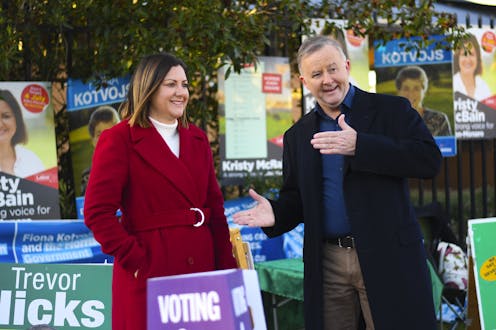Labor set to win Eden-Monaro; Andrews's ratings fall in Victoria
- Written by Adrian Beaumont, Honorary Associate, School of Mathematics and Statistics, University of Melbourne

This article was updated July 5.
With 77% of enrolled voters counted at Saturday’s Eden-Monaro byelection, Labor’s Kristy McBain currently leads the Liberals’ Fiona Kotvojs by a 50.8-49.2 projected margin in The Poll Bludger’s Eden-Monaro election page.
This page has all the numbers, including booth by booth results. The projected margin is an estimate of the margin once all votes are counted, not the current margin. McBain is given a 96% win probability. The two party projection would be a zero swing from the 2019 election.
Primary votes are currently 37.8% Liberal (up 0.8%), 36.2% Labor (down 3.0%), 6.6% National (down 0.3%), 5.6% Greens (down 3.2%) and 5.4% Shooters, Fishers and Farmers. Had preference flows at the byelection been similar to the 2019 federal election, the Liberals would have won. But Labor currently has 57% of all preferences, an 8% swing on preference flows to Labor.
While the Greens lost vote share, much of it went to Help End Marijuana Prohibition (HEMP), which won 2.4%. Labor also benefited from the “donkey vote” coming from the Shooters. The Shooters were first on the ballot paper, with Labor ahead of the Liberals.
If Labor holds on in Eden-Monaro, it will be a huge relief for Anthony Albanese. Analyst Peter Brent wrote in Inside Story that, while no government has gained an opposition-held seat at a byelection in almost a century, the lack of a personal vote for the sitting MP in opposition-held seats means they are far more likely to swing to the government at a byelection than in a government-held seat.
In 2014, the Abbott government achieved a 1.2% two party swing in former PM Kevin Rudd’s seat of Griffith at a byelection. Had that swing occurred Saturday, the Liberals would have gained Eden-Monaro. In 90 federal byelections with a Labor vs non-Labor two party count, the average swing to the opposition is 4.7%, but it is just 1.1% in opposition-held seats.
Read more: Grattan on Friday: Saturday is crucial for Albanese but July 23 is more important for Morrison
Premiers still have high ratings, but Andrews falls in Victoria
In late April, Newspoll polled the ratings of the six premiers, and this exercise was repeated last week. Samples were 500-550 for the mainland states, and 311 in Tasmania.
Tasmanian Liberal Premier Peter Gutwein had the best ratings in the June premiers’ Newspoll, at 90% satisfied, 8% dissatisfied (net +82). His satisfaction rating overtook WA Labor Premier Mark McGowan in April (89%) as the best ever for a premier or PM in Australian polling history.
Gutwein’s net approval was up nine points from April, while McGowan slid four points to a still very high 88% satisfied, 9% dissatisfied (net +79).
The biggest change in net approval was Victorian Labor Premier Daniel Andrews. His net approval fell 18 points to +40, with 67% satisfied and 27% dissatisfied. Andrews’s fall appears to be related to the recent spike in Victorian coronavirus cases, not the Adem Somyurek branch stacking affair. His net ratings on handling coronavirus fell sharply from +74 to +47.
NSW Liberal Premier Gladys Berejiklian had a +42 net approval, down from +46, with 68% satisfied and 26% dissatisfied. SA Liberal Premier Steven Marshall had a +52 net approval, up from +47, with 72% satisfied and 20% dissatisfied.
Queensland Labor Premier Annastacia Palaszczuk continued to trail with a +24 net approval, though that was up eight points. 59% were satisfied and 35% dissatisfied. The Queensland election will be held in late October.
Scott Morrison had a +41 net approval in last Monday’s federal Newspoll. Palaszczuk trails Morrison, Andrews and Berejiklian are about level, Marshall is above him, and McGowan and Gutwein are far ahead.
A good US jobs report, but there’s a long way to go
The June US jobs report was released Thursday. 4.8 million jobs were created and the unemployment rate dropped 2.2% to 11.1%. While the unemployment rate is far better than the 14.7% in April, it is far worse than during a normal economy.
The employment population ratio - the percentage of eligible Americans that are employed - rose 1.8% in June to 54.6%. But at the lowest point of the recovery from the global financial crisis, the employment ratio was 58.2%.
The surveys used for the jobs report were conducted in mid-June, before the recent spike in US coronavirus cases, which peaked at over 57,000 on Thursday. This new spike may derail an economic recovery.
Read more https://theconversation.com/labor-set-to-win-eden-monaro-andrewss-ratings-fall-in-victoria-141282

